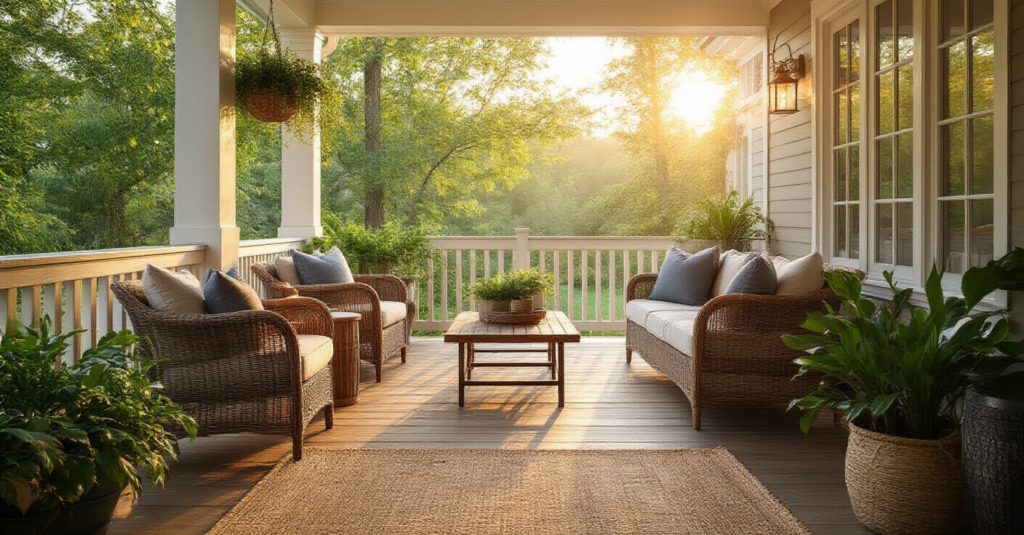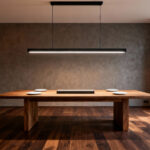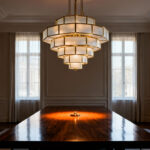Can we talk about why everyone gets back porches wrong? People go to a big-box store, buy a sad, matching set of uncomfortable metal furniture, stick a lonely grill in the corner, and call it an “outdoor living room.” It’s not. It’s a sad furniture graveyard where no one actually wants to hang out. And that, my friend, is a tragedy. Because your back porch? It’s a memory-making machine waiting to be turned on.
You know me. I believe that the best spaces are the ones that bring people together. The ones that spark conversations, that make a party flow, that make your friends want to stay for one more drink. It’s not just about aesthetics; it’s about engineering a vibe. It’s about balancing awesome tech with pure, unadulterated comfort. So forget the corporate speak and the boring lists. Here’s the real story on how to turn your porch from a forgotten slab into the undisputed social hub of your home.
Laying the Foundation: Planning & Porch Essentials
Alright, before you even think about string lights or tiki torches, we need a battle plan. This is the unsexy part that makes all the sexy parts work. Get this wrong, and you’re just putting expensive lipstick on a pig. Get it right, and you’re building a foundation for epic hangouts.
1. Define Your Porch’s Primary Purpose for Optimal Setup
So, what are we actually doing out here? Seriously. You have to answer this first. Is this the command center for game day, where sightlines to an outdoor TV are everything? Is it an intimate cocktail lounge for you and a few friends? A family zone where kids can run wild without destroying your indoor sofa? You can’t design a space that’s perfect for all of those things at once, so pick a primary mission.
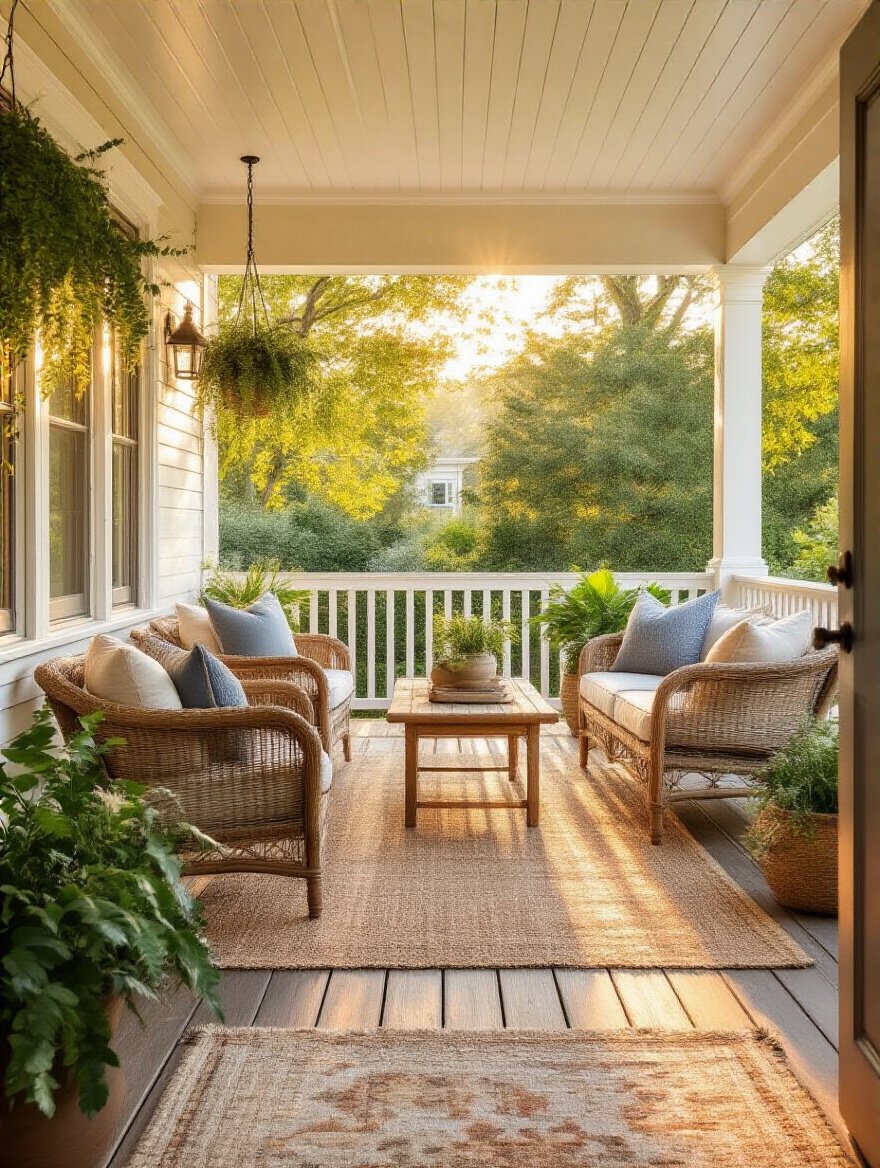
I had a client once who couldn’t decide. They wanted a “multi-purpose” space. The result was a porch that was bad at everything. The chairs were too formal for lounging but too lounge-y for dining. It became the space nobody used. We went back to the drawing board and defined its prime directive: “The Ultimate Post-Dinner Hangout Spot.” Immediately, everything clicked. We chose deep, comfy seating, warm, low lighting, and a fire pit table. Suddenly, it was the most popular room in—or out—of the house.
Defining the purpose isn’t just fluffy design-talk; it’s the GPS for every single decision you’re about to make.
2. Assess Porch Dimensions and Sun Exposure Accurately
Okay, time to face reality. Grab a tape measure. And I don’t just mean for length and width. Where are the doors? How far do they swing open? Where are the outlets? These are the non-negotiable facts of your space. But here’s the pro-level trick everyone forgets: map the sun. Spend a weekend noting where the sun is at 9 AM, at 1 PM, and, most importantly, during your prime “hangout time” at 5 PM.
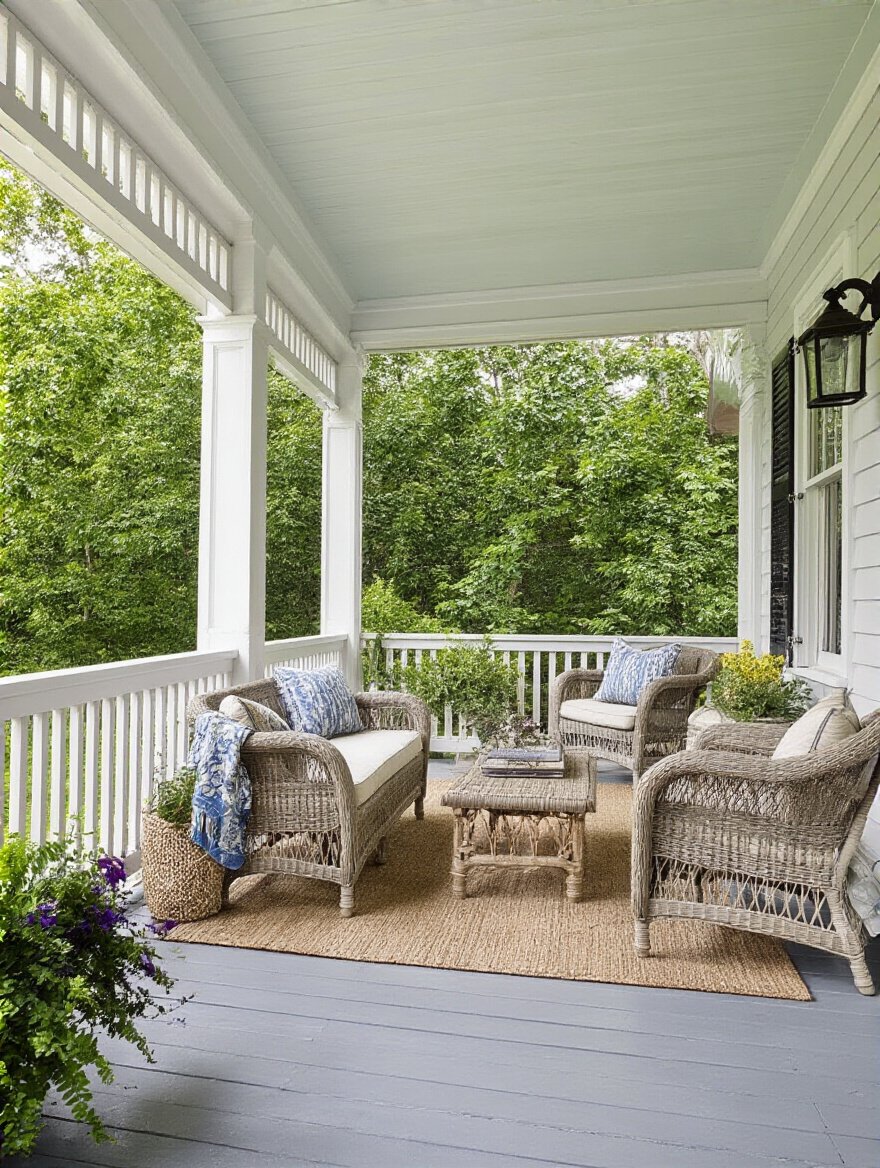
There is nothing worse than creating the perfect conversation pit only to realize it’s located in the “Surface of the Sun” zone right when your guests arrive. A friend of mine learned this the hard way after buying a beautiful, dark-colored outdoor sofa. It looked amazing until their first party, when no one could sit on it without getting a second-degree burn. Your sun map will tell you where you need shade and where you can get away with less, which dictates your entire layout.
With those hard numbers and sun-map in hand, we can move on to the fun part: picking a look that doesn’t suck.
3. Select a Cohesive Design Style to Guide All Choices
Now that we know the purpose and the physical reality, you need a vibe. And no, “stuff I like” is not a vibe. You need a North Star. Are you going for “Modern Tech-Head” with clean lines, dark metals, and integrated smart features? Or “Boho Retreat” with lots of textures, plants, and natural materials? Pick a lane. This is what stops your porch from looking like a garage sale.
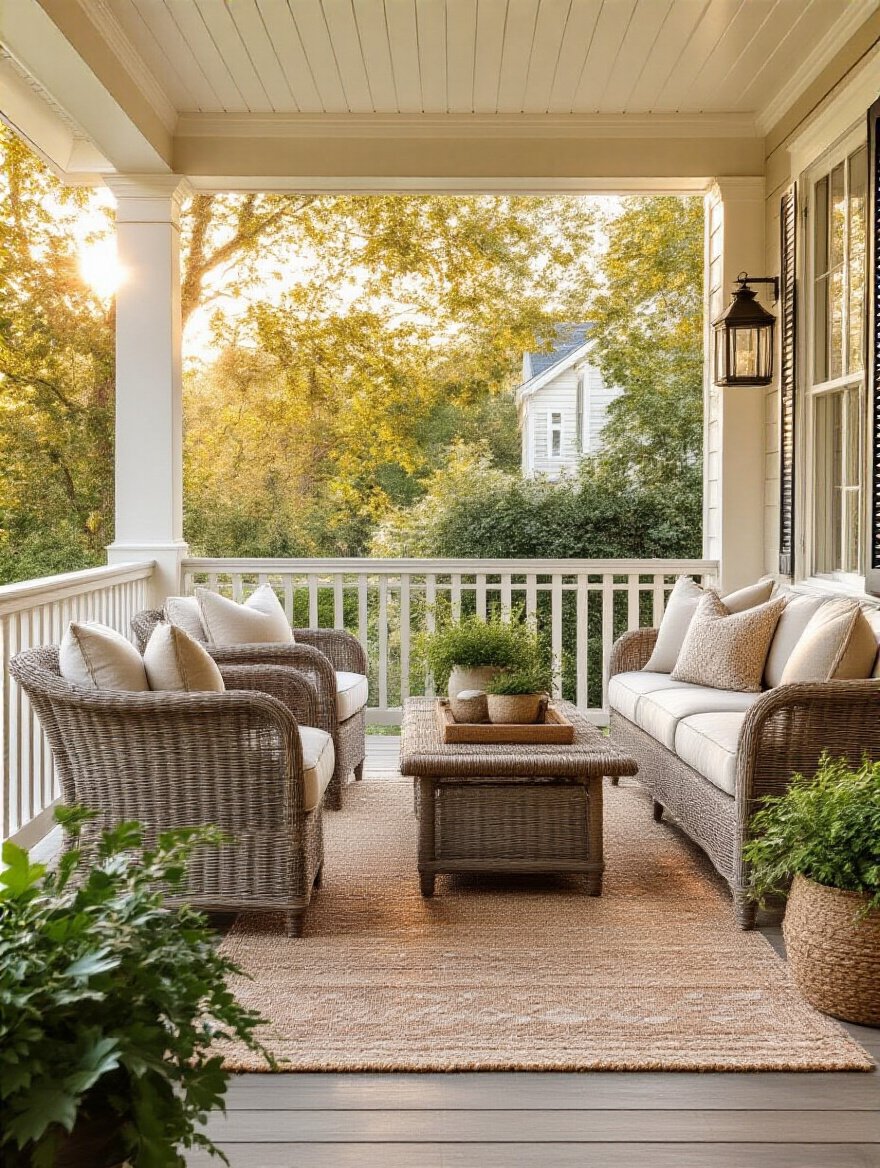
A clear style guide is your shield against impulse buys. I was working on a project where the homeowner loved a modern farmhouse look inside. But for their porch, they started buying random coastal-themed things—a driftwood sign here, a seashell-patterned pillow there. It was a mess. We had to do a hard reset. We defined the style as “Modern Cabin” to complement their interior—think warm wood, black metal, comfy-but-structured furniture. Instantly, every choice became easier, and the final result felt like a true, intentional extension of their home.
Having a style guide actually makes decorating faster and cheaper, because you’re no longer tempted by every shiny object that doesn’t fit your master plan.
4. Draft a Functional Layout for Seamless Movement Flow
You know what kills a party? A bad traffic jam. And I’m not talking about on the freeway. I’m talking about that awkward shuffle everyone has to do to get past the grill to the seating area. Your layout is all about flow. You need to create clear, wide pathways that let people move around without bumping into everything and everyone. A good rule of thumb is to have at least 30-36 inches for your main pathways.
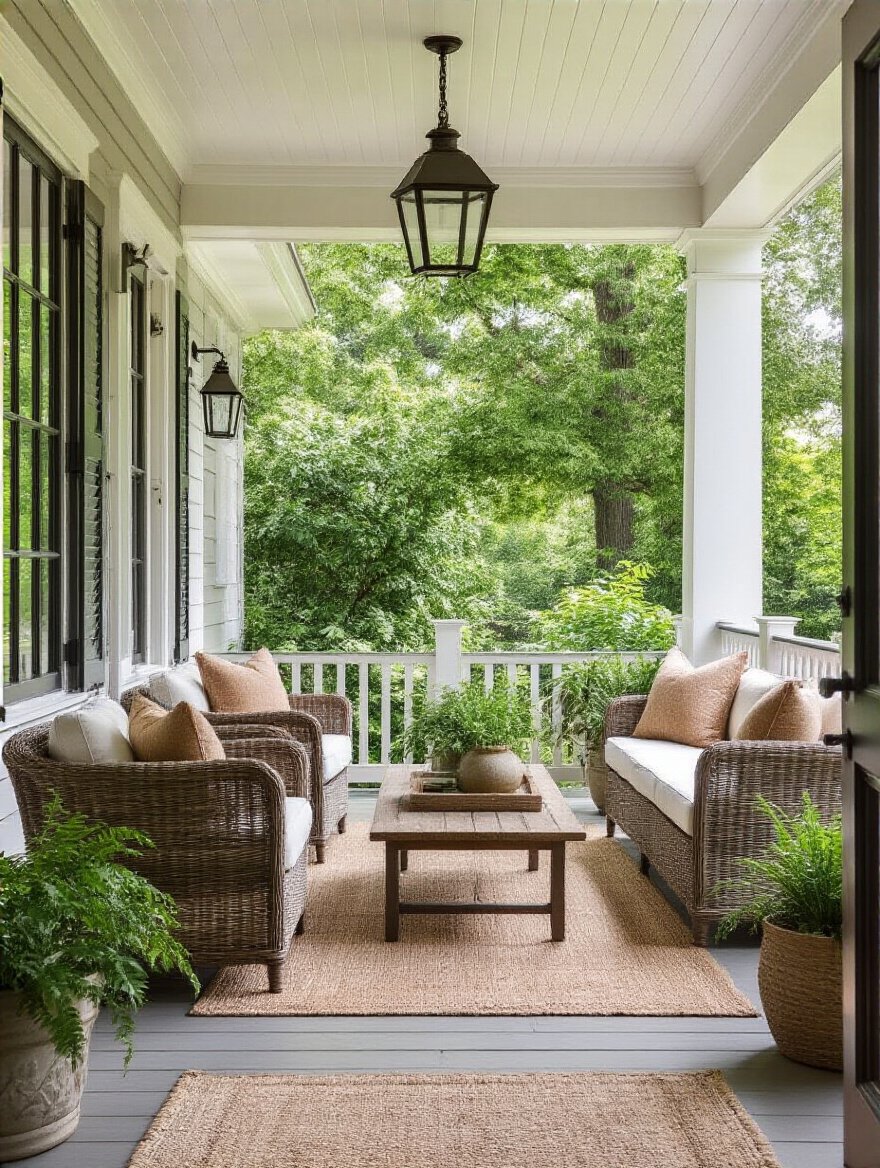
I always use painter’s tape for this. Before you buy a single thing, go out on your empty porch and tape the outlines of your dream furniture on the floor. A big L-shaped sofa, a coffee table, a couple of chairs. Then, walk through it. Can you get from the back door to the yard easily? Can someone seated get up without making everyone else move? You’ll learn more from 10 minutes with painter’s tape than from 10 hours of staring at a floor plan. This is how you design for living, not just for a catalog photo.
Once you know what fits and where, it’s time to talk money.
5. Allocate Budget Effectively for Quality, Durable Selections
Here’s the deal: everyone wants to save money. I get it. But buying cheap outdoor furniture is the fastest way to waste money. That plastic-y wicker set that seems like a bargain? It’s going to fade, crack, and look like absolute garbage in two years, and you’ll have to buy a new one. I’ve seen it a hundred times.
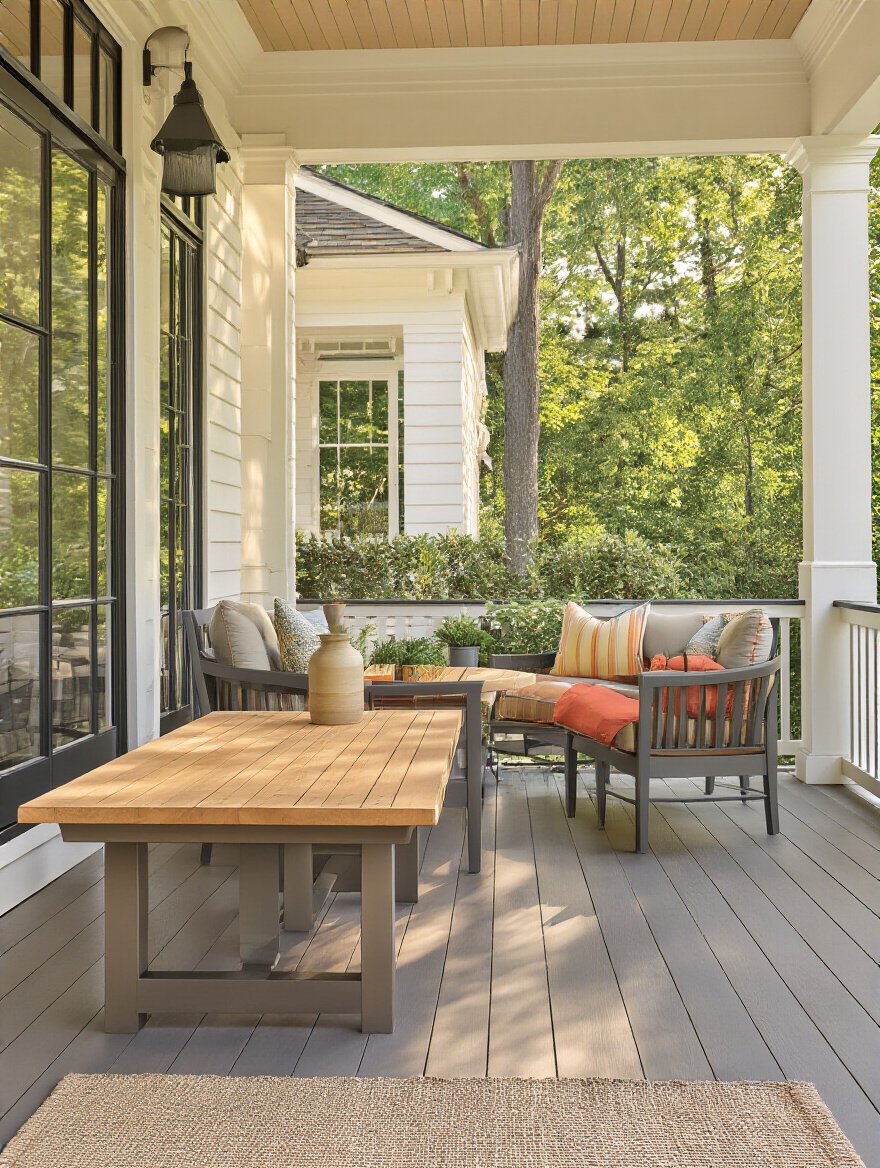
Invest your money in the things that have to fight the weather 24/7. That means the furniture frames (powder-coated aluminum or HDPE lumber are my go-tos) and the fabrics (Sunbrella or other solution-dyed acrylics are non-negotiable). These are your “forever” pieces. You can totally go cheap on the decorative pillows, the little side tables, the outdoor lanterns. Those are the things you can swap out seasonally without breaking the bank. But for the love of all that is holy, invest in the bones of the space.
Your future self, who isn’t buying a whole new patio set every other year, will thank you.
6. Prioritize Weather-Resistant Materials for Lasting Enjoyment
This is basically a continuation of the last point, but it’s so important it needs its own spot. Materials matter more outside than they do inside. Inside, a chair has to deal with… you sitting on it. Outside, a chair has to deal with blistering UV rays, torrential rain, humidity, snow, and birds. It’s a war zone out there.
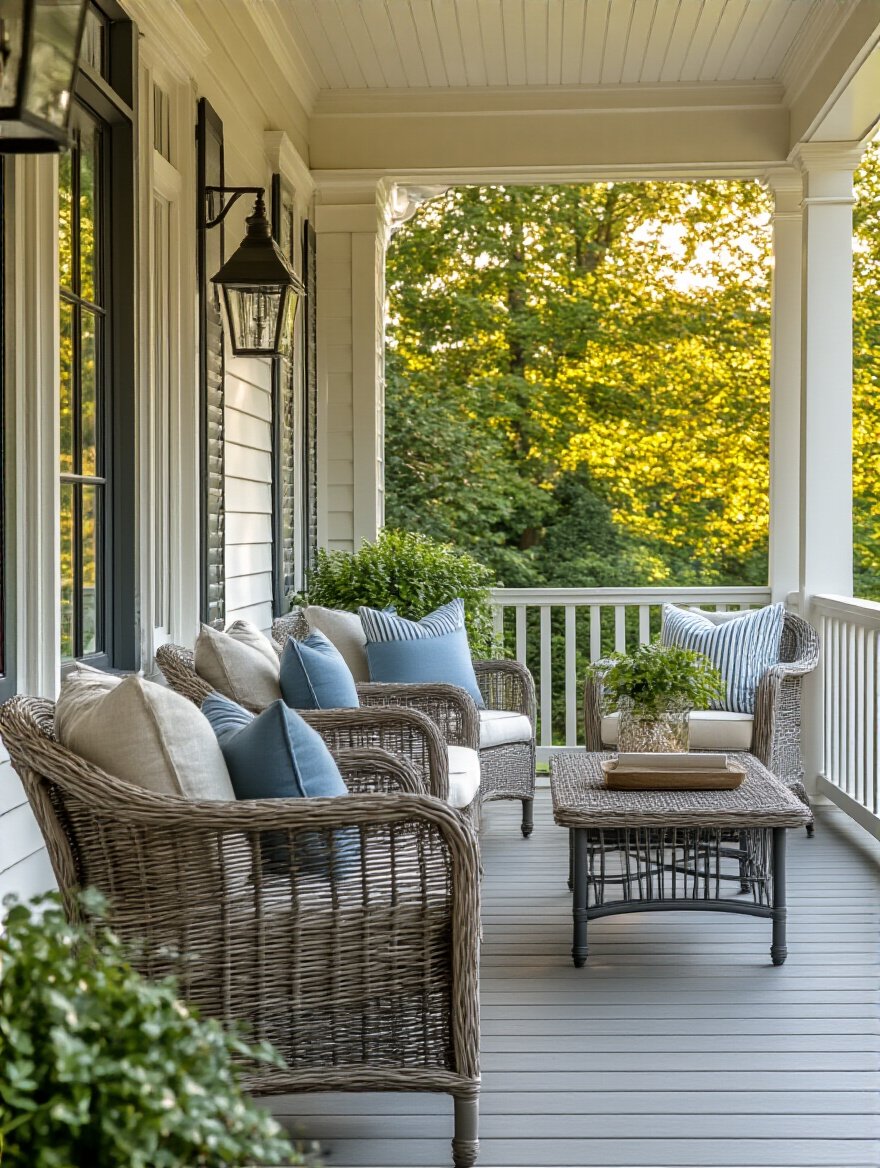
Think about total cost of ownership. That $500 set that lasts two years costs you $250 per year. That $1500 set with a 10-year warranty? That’s $150 a year. You’re literally saving money by spending more upfront. Look for materials designed for the apocalypse: Marine-grade polymer (HDPE), powder-coated aluminum frames, and fabrics that say “solution-dyed” on the tag. It means the color goes all the way through the fiber, so it physically can’t fade. It’s the difference between a carrot (colored all the way through) and a radish (only red on the outside). You want the carrot.
Now that the serious planning is done, let’s start filling this awesome space you’ve designed.
Strategic Furnishing: Maximizing Your outdoor space
The plan is locked. The materials are chosen. Now we get to the fun stuff: picking the actual gear that will make your porch the place to be. This is where we turn that empty space into a functional, comfortable, and seriously cool hangout zone.
7. Choose Comfortable, Ergonomic Seating for Extended Enjoyment
If the chairs aren’t comfortable, people won’t stay. It’s that simple. Forget how it looks for a second. Go sit in it. Can you imagine yourself sinking into that chair with a drink and talking for two hours? If the answer is no, do not buy it. Look for deep seats, supportive cushions, and a backrest that actually, you know, supports your back.

I always tell my clients, “The butt test is the most important test.” Sit in the chair in the store. Lean back. Slouch a little. Put your feet up. Does it feel good? A real “I could fall asleep here” good? That’s the one. I had a client who almost bought these super sleek, minimalist chairs. They looked incredible. Then I made him sit in one for 10 minutes. He was squirming in five. We ended up with a less “architectural” but infinitely more comfortable modular sofa, and now his friends never want to leave. That’s the goal.
Comfort isn’t a luxury; it’s the core function of a social space.
8. Select the Right-Sized Dining or Coffee Table for Functionality
Your table is the functional hub of a zone. But get the size wrong, and it kills the whole vibe. A coffee table that’s too big makes the space feel cramped. One that’s too small looks pathetic and can’t hold more than two drinks. The rule of thumb: you want about 14-18 inches of space between your sofa’s edge and your coffee table’s edge. That’s close enough to reach your snacks but far enough to get your legs through.
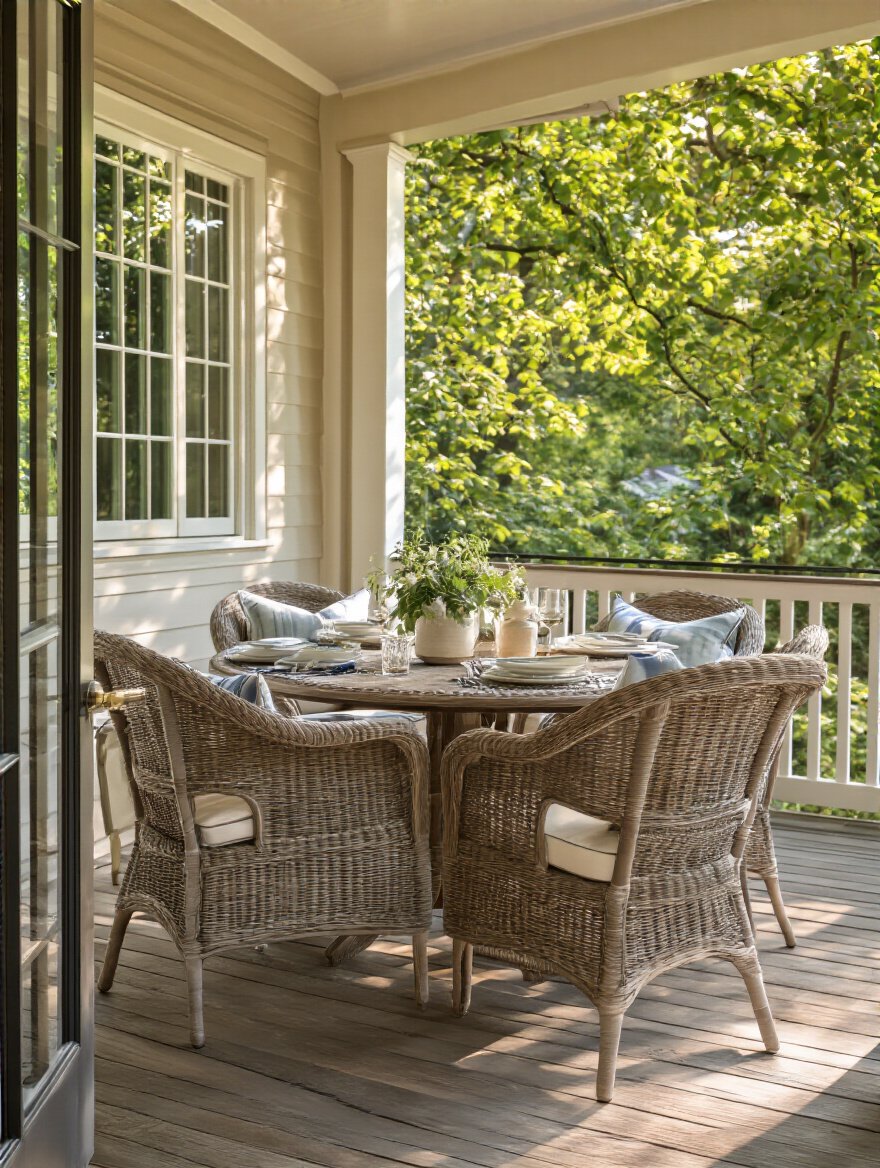
For dining tables, the big mistake is forgetting about “pull-back” space. You need a solid 24-30 inches behind each chair for people to comfortably pull their chair out and get up without making the whole table move. If you have a smaller porch, don’t try to cram a massive 8-person dining table in there. Opt for a stylish, high-top bistro table with a couple of stools. It gives you the dining function without eating up your entire floor plan.
Proportion is everything. A well-sized table makes a space feel intentional and effortless.
9. Define Distinct Activity Zones for Multifunctional Use
Even on a small porch, you can have zones. This is what makes a space feel dynamic. You might have your “lounge zone” with the big sofa and a coffee table, and then in another corner, a “quiet zone” with a single comfy armchair and a small side table for a drink and a book. You create these zones using visual cues. An outdoor rug is the easiest way to anchor a zone. The edge of the rug basically says, “This is the conversation area.”
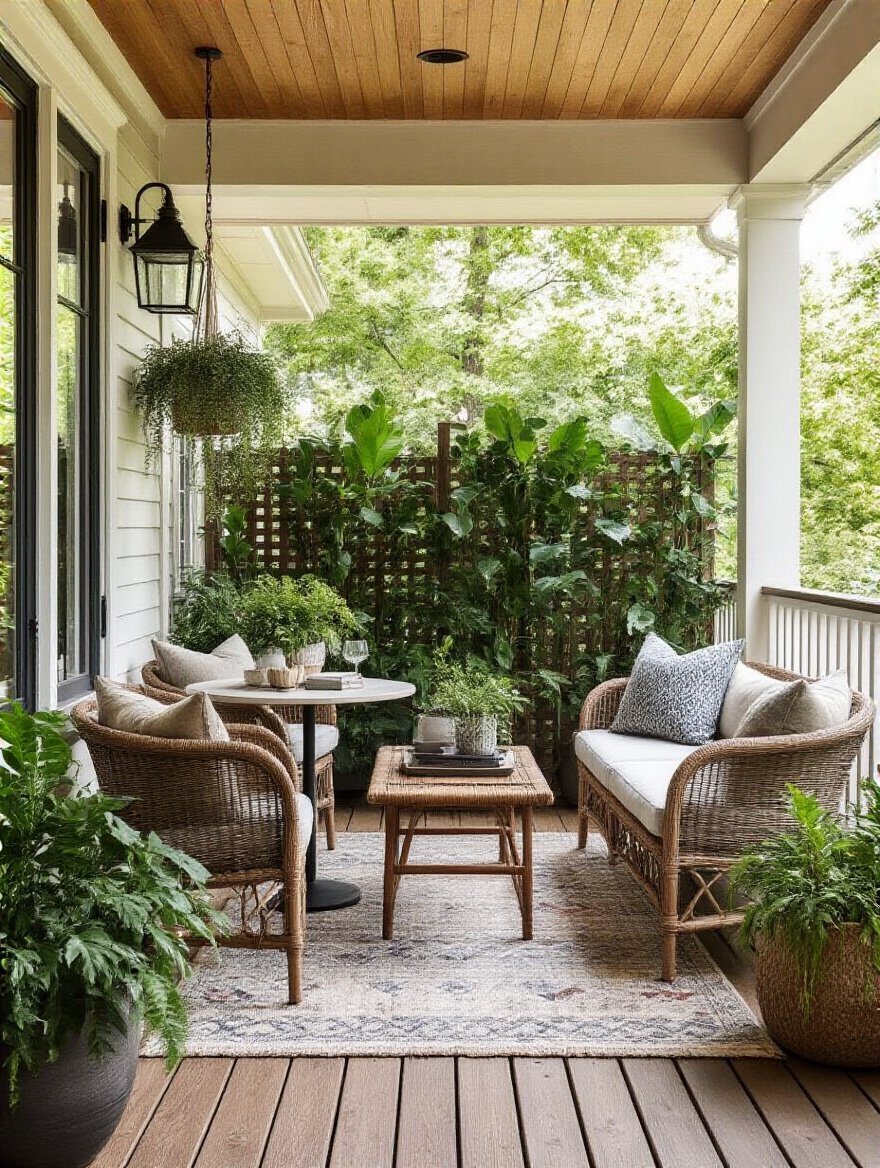
The back of a sofa is a powerful tool for this. It can act as a low wall, separating the main lounge area from, say, a small dining spot. I did this on a long, narrow porch. We used an outdoor sofa to create a “room,” and behind it, we put a thin console table that served as a bar and buffet area during parties. It instantly gave the single space two distinct functions and made it feel twice as big and infinitely more useful for hosting.
Zoning turns a single space into a multi-tool for entertaining.
10. Anchor Your Space with a Proportionate Outdoor Rug
An outdoor rug is the single fastest way to make a porch feel like a real room. Without one, your furniture looks like it’s just floating in space. A rug pulls everything together, anchors it, and says, “This is a deliberate, cohesive area.” It’s a game-changer. But please, for the love of god, get the right size.
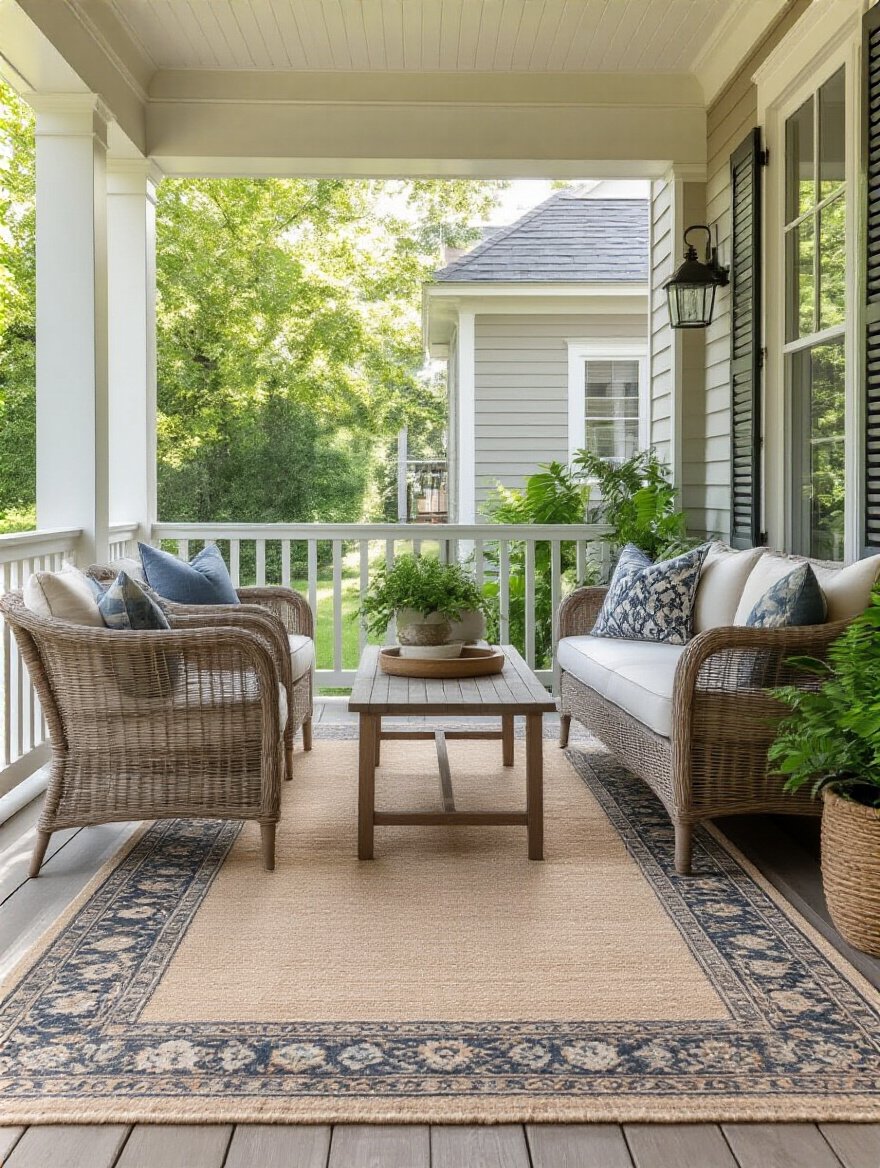
Here’s the non-negotiable rule: at least the front legs of all your main furniture pieces must be on the rug. ALL OF THEM. A tiny little rug sitting in the middle of your furniture arrangement (I call it a “rug island”) looks cheap and makes the whole space feel smaller. When in doubt, go bigger. It will always look more luxurious and intentional. And stick to polypropylene or other synthetic materials that can handle getting rained on and are easy to hose off.
Don’t skip the rug. It’s the foundation of your entire visual design.
11. Opt for Modular Furniture to Maximize Small Spaces
If you have a small porch, modular furniture is your superpower. It’s the ultimate in flexibility. I’m talking about sectionals that are made of individual, lightweight pieces you can move around. One day, you have a classic L-shaped sofa. The next, for a party, you can break it apart into two separate love seats and an ottoman to create better flow and more conversation areas.
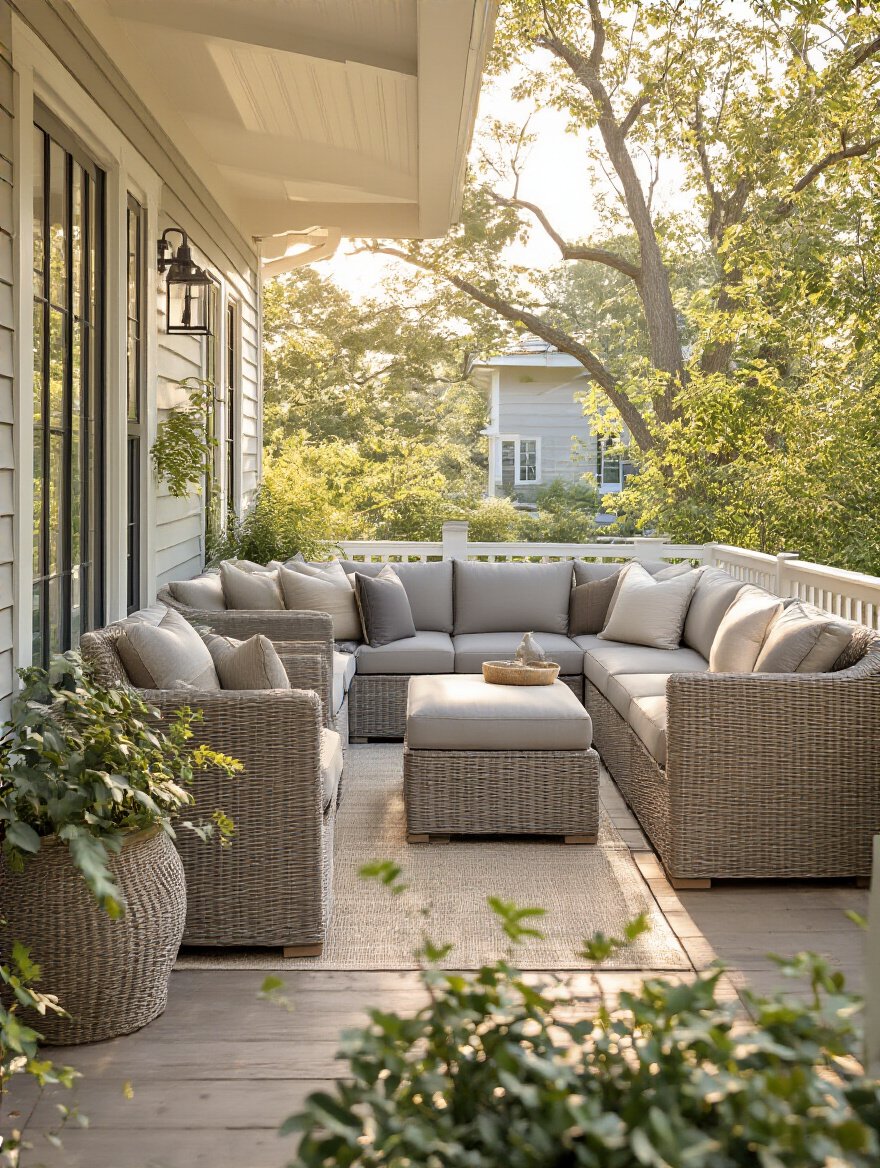
I’m a huge fan of this for entertainment spaces. It allows the space to adapt to the event. For a family movie night with an outdoor projector, you can push all the pieces together to create one giant “cuddle puddle.” For a game-day party, you can arrange it so everyone has a great view of the screen. A static sofa can’t do that. Modular pieces mean your furniture works for you, not the other way around. It’s the smart, tech-forward way to think about seating.
With the big pieces in place, it’s time to add the layers that create a true vibe.
Crafting Comfort: Ambiance & Personal Touches
Okay, the bones are good. The furniture is comfy and functional. Now it’s time for the magic. This is the stuff that engages the senses and makes a space feel truly special—the lighting, the textures, the little personal details that make it your space and not a showroom.
12. Strategically Place Outdoor Lighting for Evening Ambiance
Forget that single, glaring security light. It’s not lighting, it’s an interrogation tactic. Real outdoor lighting is about layers. First, you need ambient light—a warm, general glow. My go-to is commercial-grade string lights with dimmable Edison bulbs. Always, always put them on a dimmer. The ideal color temperature for a cozy vibe is around 2200K to 2700K. Anything higher starts to feel like a hospital.

Next, add task lighting. This is focused light where you need it, like a small spotlight over the grill or a sconce next to the door. Finally, accent lighting. This is the fun stuff—uplighting a cool plant or putting a small LED lantern on a table. And this is all a perfect job for a smart-home setup. Connecting your lights to a system like Philips Hue lets you control the brightness, the color, and set scenes right from your phone. “Hey Google, set the porch to ‘Chill Mode’.” That’s how you build a vibe.
13. Introduce Lush Greenery with Diverse Potted Plants
Plants make any space feel more alive, but on a porch, they do double duty. First, yes, they look great and soften all the hard edges of your house and furniture. But from a tech perspective, they’re also fantastic, natural sound absorbers. On a covered porch with an outdoor sound system, big leafy plants can help reduce echo and sound bounce, making your music sound clearer and richer.
Mix it up. Use the “thriller, filler, spiller” method for your pots: something tall and dramatic (the thriller), something bushy to fill in the middle (the filler), and something that trails over the edge (the spiller). Group pots in odd numbers—it just looks more natural. And use pots of different sizes and heights to create layers and visual interest. It turns your porch from a simple patio into a lush escape.
Once you have sight and sound covered, it’s time for touch.
14. Incorporate Colorful, Patterned Textiles for Instant Visual Interest
This is the easiest, cheapest way to inject personality and change up the look of your porch. Outdoor pillows, throws, and even the rug are your tools for adding color and pattern. You can have a solid, neutral-colored sofa that will last you a decade, and completely transform its look every year just by swapping out the pillows.
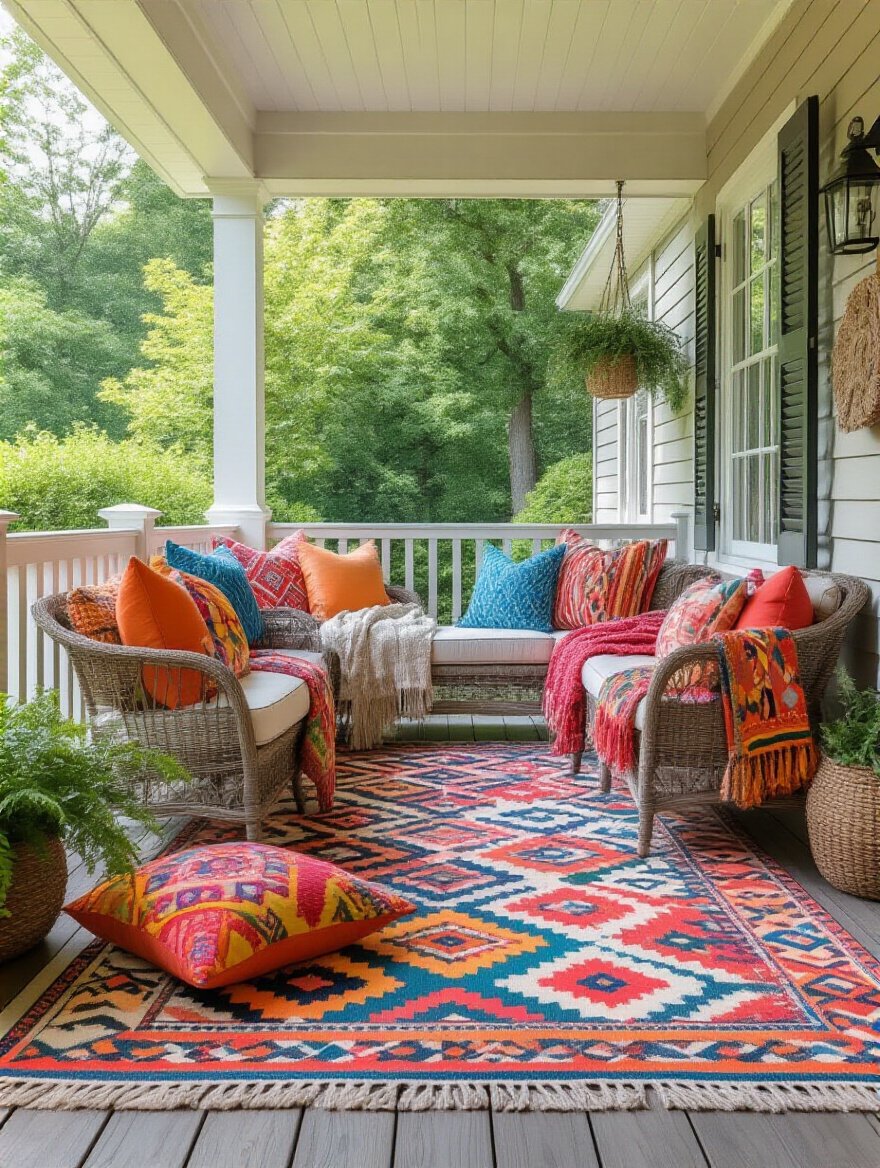
The secret to mixing patterns like a pro is to vary the scale. Pick one large, bold pattern (like a big geometric on your rug), one medium pattern (maybe a floral on a couple of pillows), and one small, simple pattern (like a thin stripe on another pillow). As long as they share one or two common colors, they’ll look dynamic and curated, not chaotic. And remember: Sunbrella or other outdoor-rated fabrics only! Don’t bring your indoor pillows outside unless you want them to become mildewy science experiments.
These soft touches make the space feel finished and incredibly inviting.
15. Add Decorative Accents Reflecting Your Personal Flair
This is the final layer: the stuff that makes the space yours. It could be a cool piece of metal art on the wall, a set of lanterns you picked up on vacation, or a funky serving tray. This is where you tell your story. Avoid generic, mass-produced “Live, Laugh, Lounge” signs. Instead, find something that means something to you.

I once worked with a client who was a huge sci-fi nerd. We found some awesome, subtly-themed-but-still-stylish posters from his favorite movies, had them printed on weather-resistant metal, and hung them as a triptych on a big empty wall. It was a massive hit. It was personal, it was a conversation starter, and it was 100% them. Your porch should feel like an extension of your personality, not a page out of a catalog.
Next up, let’s talk about the practical magic that makes a good porch great.
16. Install Outdoor Curtains or Blinds for Privacy and Shade
If your neighbors are a little too close for comfort, or if you have a “Surface of the Sun” problem like we talked about earlier, outdoor curtains are a total game-changer. They can instantly turn an exposed porch into a private, breezy cabana. They soften the look of the space, add a touch of elegance, and give you control over privacy and light.
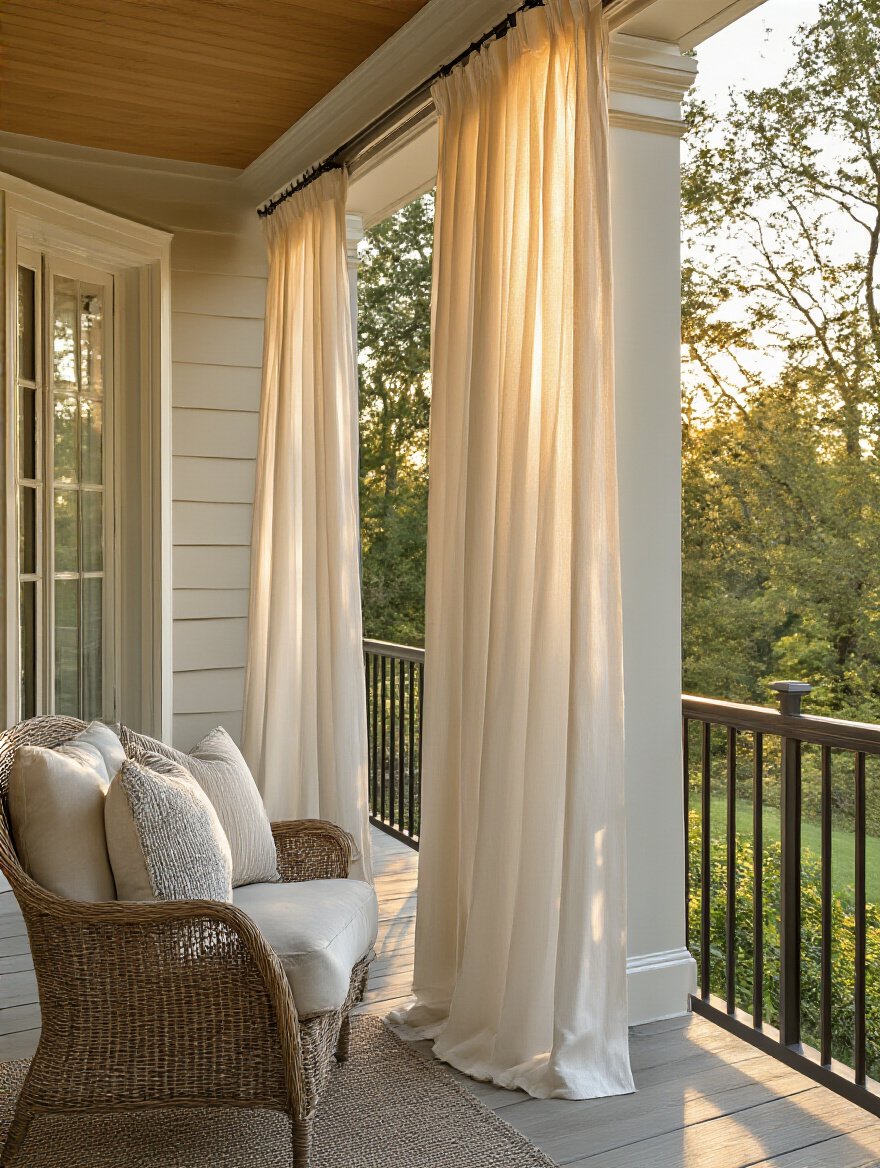
Make sure you get real outdoor curtains made from weather-resistant fabric, and hang them on a sturdy, rust-proof rod. A critical pro tip: weigh down the bottom hems. You can buy little drapery weights or just sew a channel and slide in a small chain. This keeps them from flying all over the place in a breeze, which looks messy and is super annoying when you’re trying to relax. It’s a small detail that makes a world of difference.
From visual privacy to aural privacy, let’s talk about scent.
17. Select Scented Plants to Naturally Enhance Sensory Appeal
Scent is the most underrated tool in design. You can create an entire mood just with fragrance. Strategically placing pots of scented plants like lavender, jasmine, or even a citrusy herb like lemon verbena near your seating areas adds an incredible, subtle layer to the experience. It makes the space feel more like a luxury spa and less like a backyard.
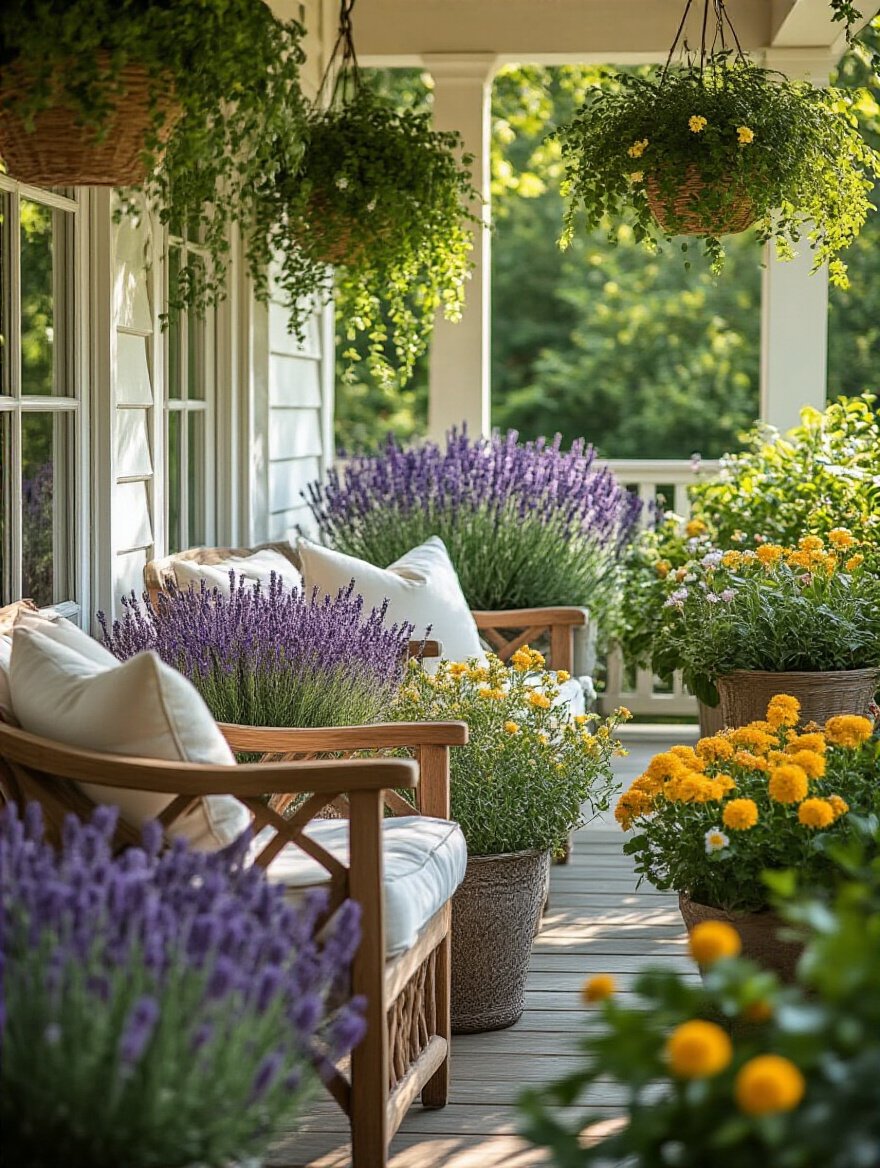
This is also a great way to put a functional spin on your greenery. Plants like citronella, lemongrass, and mint are known to be natural mosquito repellents. A few pots of those around the perimeter of your porch won’t create an impenetrable force field, but they can definitely help keep the bug situation more manageable. It’s a win-win: smells great, looks great, and serves a practical purpose.
Now that we’ve perfected the vibe, let’s dial in the hardcore practical stuff that will make you love this space for years.
Enhancing & Enduring: Practicality & Seasonal Charm
This is the final boss level of porch design. We’re moving beyond just making it look good for one season. This is about making it functional, durable, and awesome year-round. This is how you future-proof your investment in outdoor happiness.
18. Install a Ceiling Fan for Superior Air Circulation
If you have a covered porch and live anywhere that gets even remotely warm, an outdoor-rated ceiling fan is not a luxury. It is a necessity. It’s the single best upgrade you can make for pure, physical comfort. The breeze it creates can make the air feel 4-8 degrees cooler, turning a sticky, unbearable afternoon into a pleasant one.
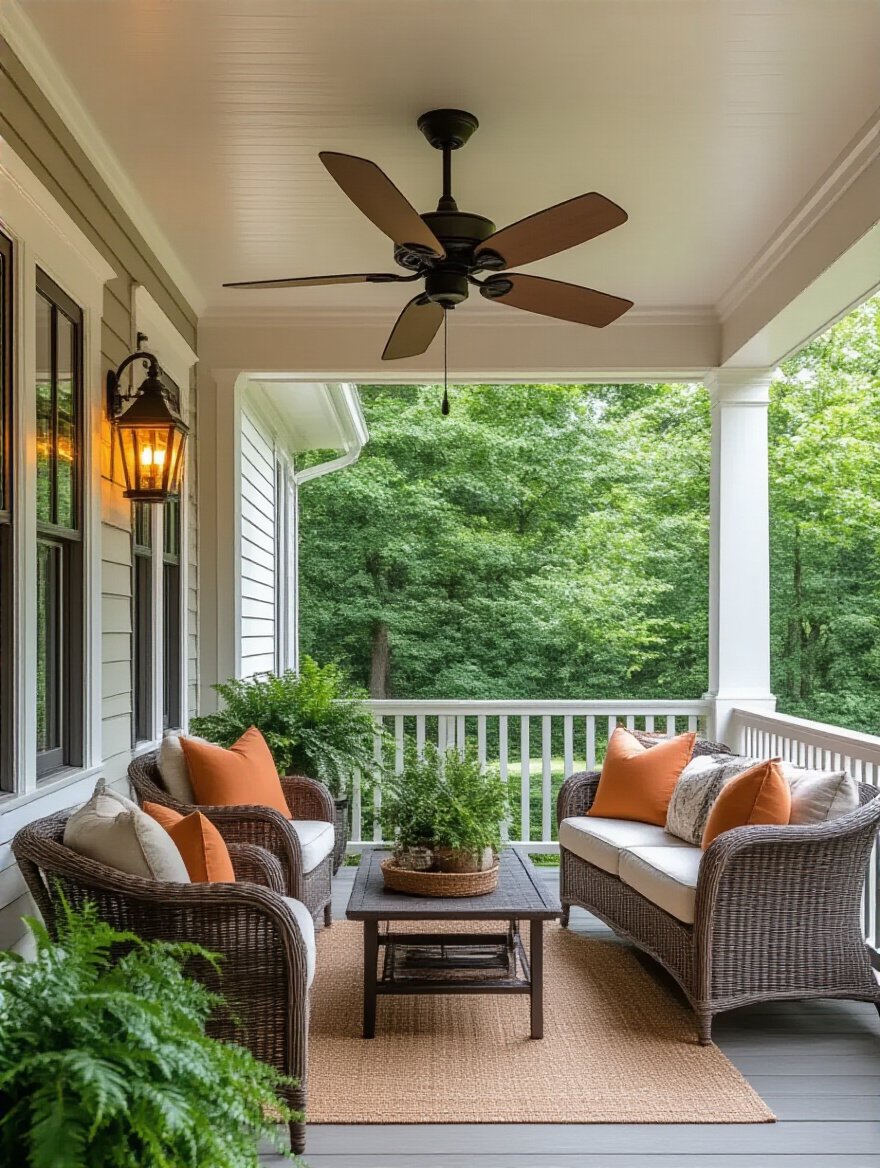
But here’s the host-centric reason it’s a must-have: it keeps flying insects away. Mosquitoes and flies are terrible flyers. The constant breeze from a fan makes it incredibly difficult for them to navigate, so they’ll generally steer clear of your seating area—and more importantly, your food and drinks. Just make sure you get one that’s “wet-rated” for fully exposed porches or “damp-rated” for covered ones. It makes a huge difference in its longevity.
From moving air to moving drinks, let’s streamline your hosting duties.
19. Design a Dedicated Outdoor Refreshment Station for Guests
The number one sign of a great party is a host who is actually enjoying it, not running back and forth to the kitchen every five minutes. A dedicated refreshment station is your secret weapon. This could be as simple as a stylish bar cart or as complex as a built-in counter with an outdoor mini-fridge. The goal is to have drinks, ice, glasses, and snacks readily available right on the porch.
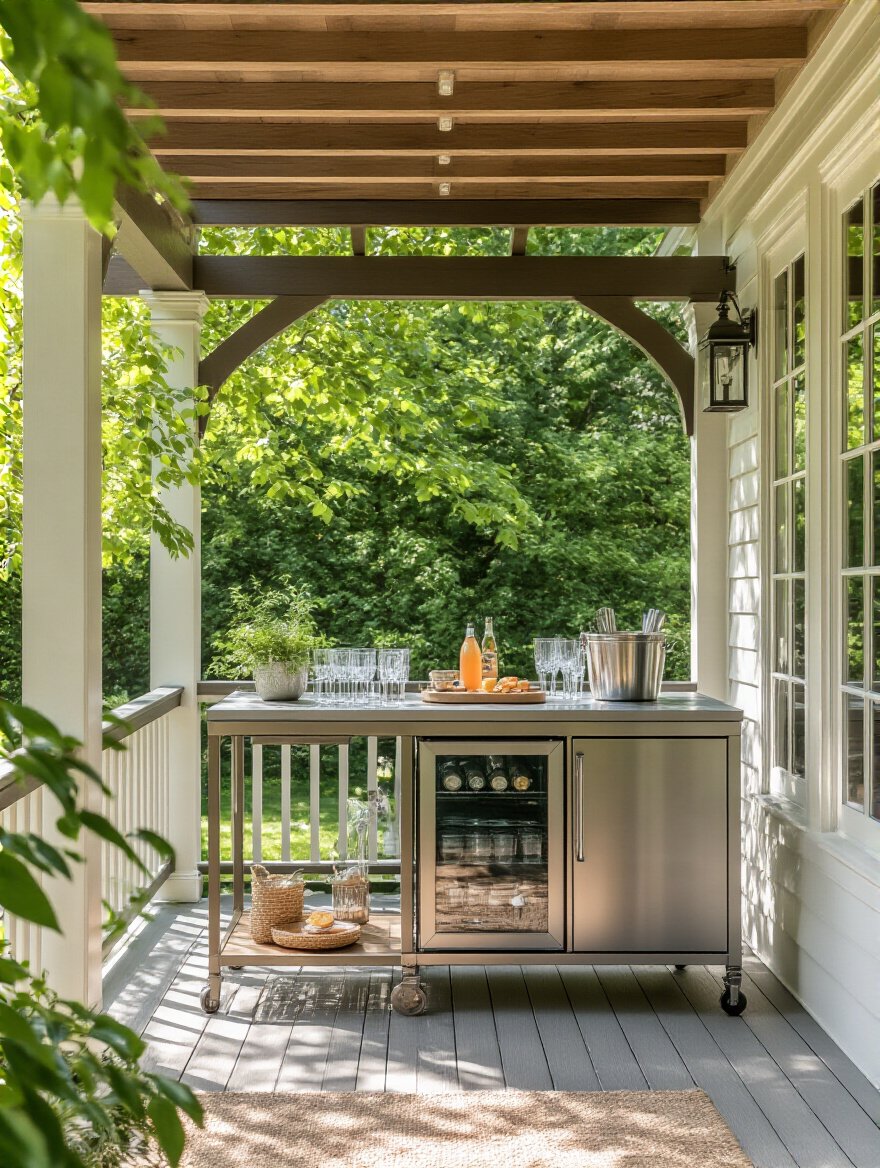
This does two amazing things. First, it empowers your guests to help themselves, making them feel more at home. Second, it keeps foot traffic out of your house, which means less mess inside and more social time for you outside. I had a client install a small outdoor-rated beverage fridge and it completely changed how they entertained. It became the hub, and he could actually sit down and talk to his friends instead of playing bartender all night.
This is a hosting power move, pure and simple.
20. Integrate Smart storage solutions for a Clutter-Free Porch
Clutter is the enemy of relaxation. Pillows strewn everywhere, kids’ toys, gardening tools—it all adds to a sense of chaos. Smart storage is the cure. And I don’t mean a big, ugly plastic deck box. The best storage is the storage you don’t see. Look for multi-functional furniture. Ottomans with lids that lift up, benches with hidden compartments, coffee tables with drawers.
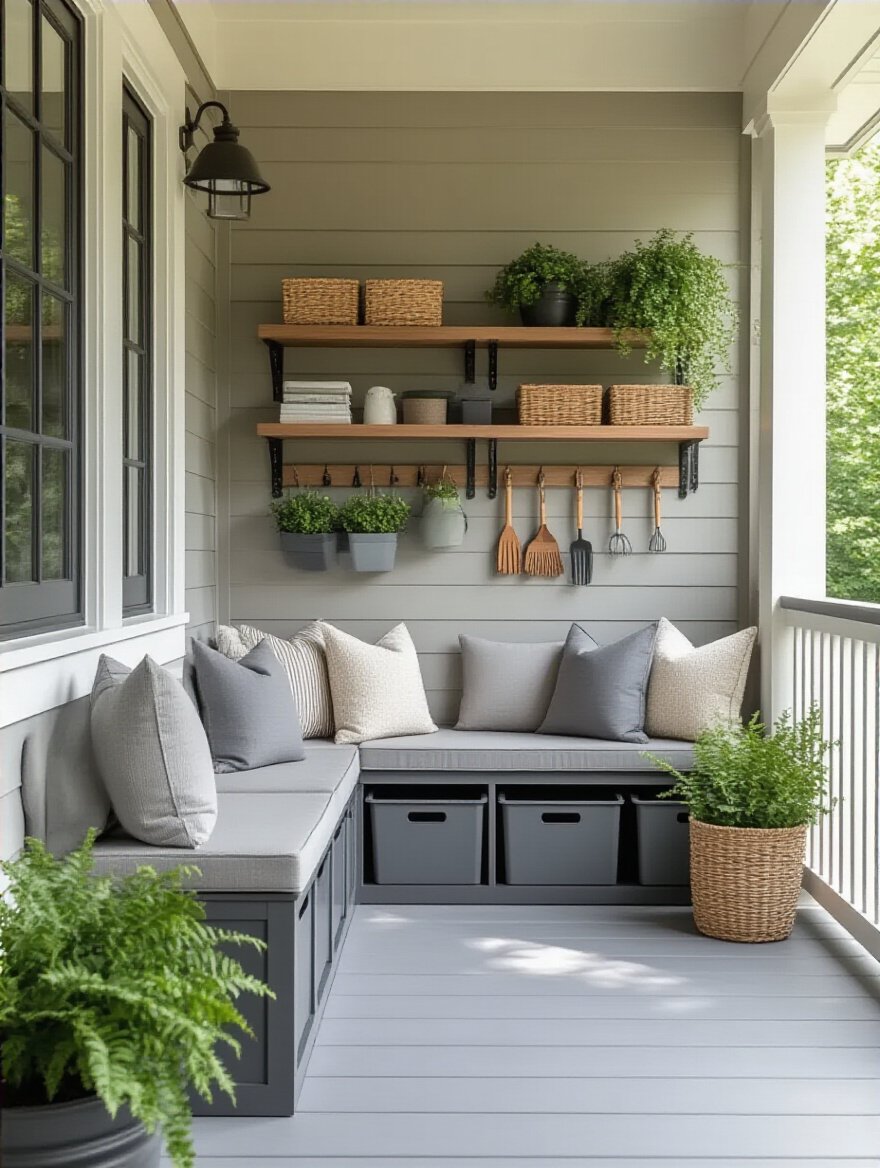
This is about protecting your investment, too. Those expensive outdoor cushions and pillows will last years longer if they’re stored away from the sun and rain when you’re not using them. Having a dedicated, convenient spot for everything makes cleanup a breeze and keeps your porch looking serene and inviting at all times. Think of it as building the organization right into the furniture itself.
From keeping things tidy to keeping things fresh…
21. Plan Seasonal Decor Swaps for Fresh, Year-Round Appeal
Your porch shouldn’t have the same exact look in October as it does in July. Planning for seasonal swaps keeps the space from feeling stale and gives you an excuse to refresh the vibe. This doesn’t have to be a huge, expensive overhaul. It’s as simple as having a different set of pillow covers and a throw blanket for each season.
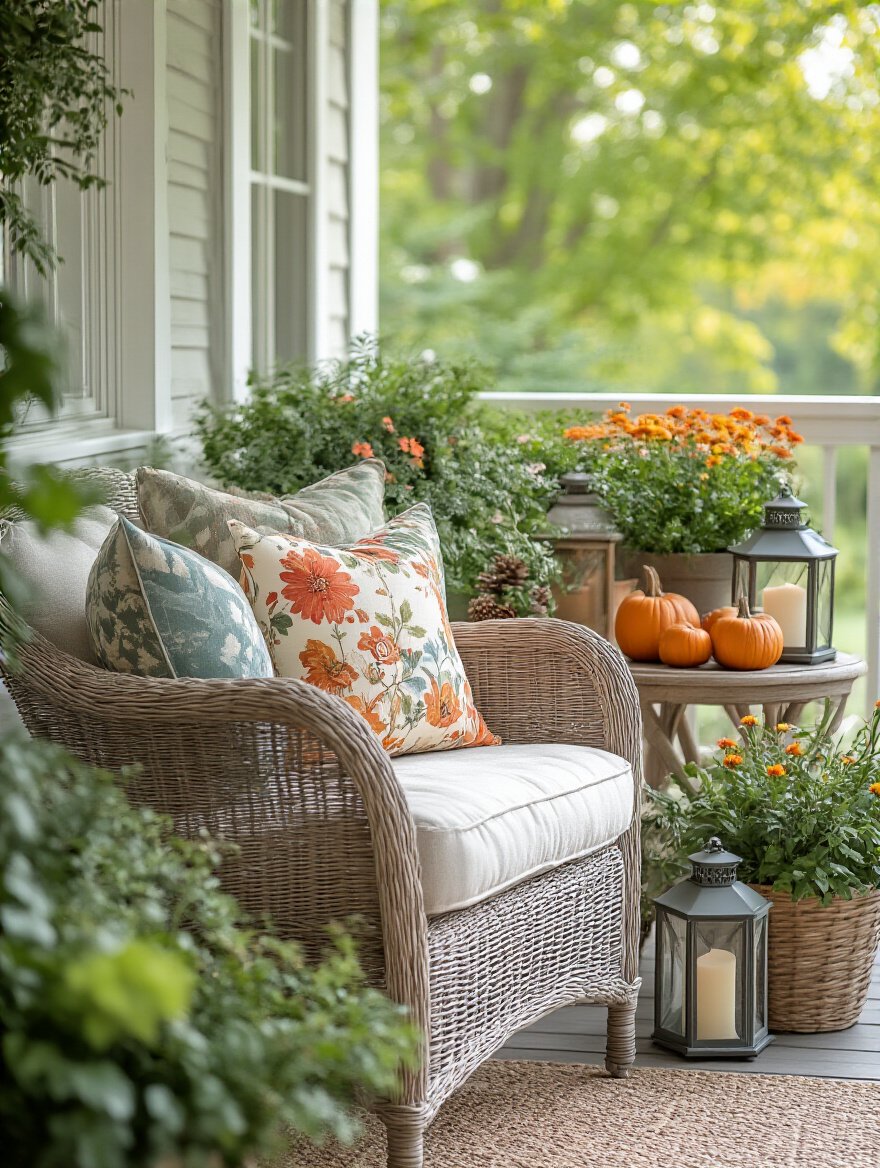
For my own porch, I have a “Summer Kit” (bright blues and whites, lightweight throws) and a “Fall/Winter Kit” (deep oranges and plaids, chunky knit blankets). The swap takes me all of 15 minutes and it completely changes the mood of the space. Keep a couple of labeled storage bins in the garage, and you can reinvent your porch four times a year with minimal effort and cost. It ensures your porch is a dynamic, evolving space that’s always inviting.
To make those swaps last, you need the right materials.
22. Choose Durable, Easy-to-Clean Fabrics for Practical Longevity
We touched on this before, but let’s be crystal clear. For anything fabric-based outdoors—cushions, pillows, rugs—your mantra should be “solution-dyed acrylic.” That’s the technical term for fabrics like Sunbrella. They cost more upfront, and they are worth every single penny. They are fade-proof, mildew-resistant, and incredibly easy to clean. Most spills can be wiped away with just soap and water.
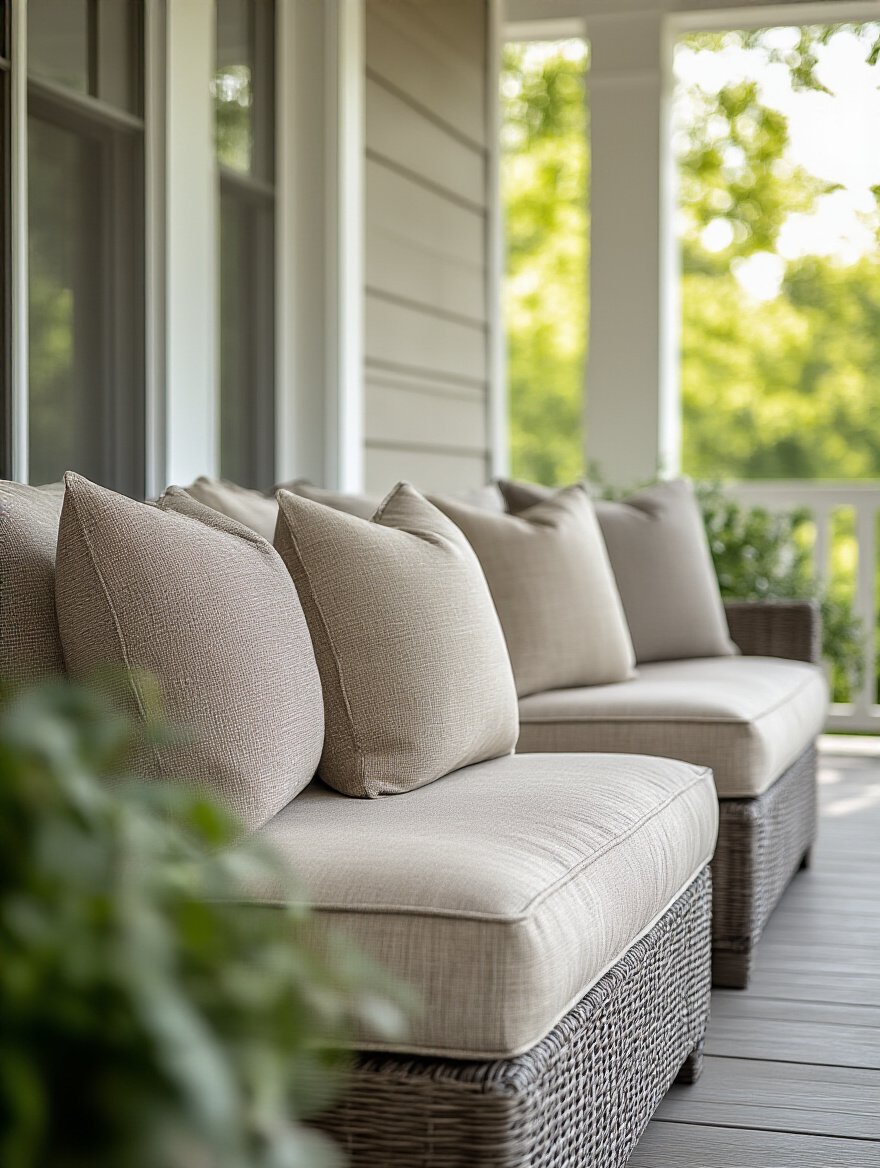
I once saw a side-by-side comparison of a client’s old, cheap polyester cushions next to their new Sunbrella ones after just one season. The cheap ones were faded, stained, and looked a decade old. The Sunbrella cushions looked brand new. This isn’t just an aesthetic choice; it’s a financial one. Buying the right fabric once is infinitely cheaper than buying the wrong fabric three times.
Finally, let’s add one last layer of sensory zen.
23. Create a Serene Water Feature for Calming Sensory Escape
A small, self-contained water feature can be a phenomenal addition. The gentle sound of trickling water is incredibly relaxing and, more practically, it’s fantastic at masking unwanted background noise like traffic or your neighbor’s lawnmower. It’s like a natural white noise machine that adds a huge sense of tranquility to the space.

The key here is subtlety. You want a gentle burble, not Niagara Falls. A loud, splashing fountain can actually kill conversation, which is the opposite of our goal. A small tabletop fountain or a bubbler-style feature is often all you need. Pair it with some subtle, low-voltage submersible lighting, and you’ve created a stunning and serene focal point that works day and night. It’s the perfect final touch for a true outdoor sanctuary.
Your Porch, Your Social Hub
So, there you have it. Your back porch isn’t just leftover space. It’s a blank canvas with the potential to be the heart of your home’s social life. It’s where you’ll have late-night talks, celebrate birthdays, and watch the big game with your best friends. It’s an investment in your own happiness and in the memories you’re going to create.
Don’t get overwhelmed. Just start. Walk out there, take a good, hard look, and pick one thing from this list to tackle this weekend. Maybe it’s just getting an outdoor rug to anchor your seating. Maybe it’s finally installing that dimmer switch. Every small step moves you closer to transforming that patch of concrete into a place where people truly, deeply want to be. Build it right, and they will come. And they won’t want to leave.
